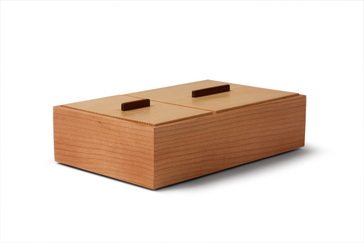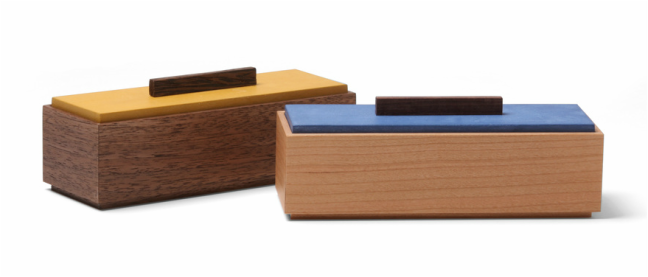 Box with two compartments. Cherry, spruce, cocobolo. 2 in. x 5 in. x 8 in. Box with two compartments. Cherry, spruce, cocobolo. 2 in. x 5 in. x 8 in. These are boxes 1 and 2 in my 52 weeks, 52 boxes challenge. I wanted to make a small, delicate box. But then I thought the box would like nice as a pair, so I made one in walnut and one in cherry. I'm happy with how they turned out. Together, they make a bold graphic statement, and they should remain a pair, I think. I made them both in the first week of the challenge. I like the proportions: just over 1 1/2 in. tall, 1 3/4 in. wide, and 5 in. long. That's really small, but I think that I can go smaller. I'm sure I'll give it a try later in the challenge. I should note that because the ends are so short, I cut the sides apart with a dozuki, and squared up the ends at my shooting board. I then cut the miters at the shooting board, too. This technique resulted in a very good four corner grain match, because cutting out the sides and mitering the ends removed very, very little material. I think I'll continue to make small boxes this way going forward. (It also helps to start out by resawing with a thin-kerf bandsaw blade.) The overall design is similar to other boxes that I've made, like the box with two compartments in the photo above. The big difference is that this new box has a single, painted lid instead of two wooden (spruce) lids finished with shellac. This is the sixth box I've made using the same key design elements as a jumping off point. I also tried out a new technique on this box. On previous boxes, I used a solid wood bottom that I rabbeted. The resulting tongue on the bottom's edge fits into a groove in the box sides. The sides of this little walnut box are far too thin (less than 3/16 in.) to hold a groove. Instead, I rabbeted the bottom edge of the sides, and glued the bottom into the rabbet. Don't worry, it's not a solid wood bottom. I veneered a thin (3/16 in. thick) piece of walnut to each face of the plywood, trimmed them flush to the edges, and then glued walnut edging to all four sides. The walnut veneers were glued down perpendicular to the grain on the plywood's surface veneers. There won't be any seasonal movement, so there shouldn't be any problems. I got the idea for the bottom from how I make backs for wall cabinets. There is one other construction technique worth mentioning. I typically glue lid lifts on with cynoacrylate glue, but that wouldn't work here. I'm sure the glue would stick to the milk paint, but it could come undone eventually. So, I drilled two pilot holes in the top, drove in some little brad nails and snipped off their heads, leaving about 1/4 in. of nail sticking out. I drilled holes in the lift, dropped some glue into the holes, and put the lift on the nails. It worked brilliantly.
16 Comments
Jurgen01
5/6/2015 04:10:05 am
Matt,
Reply
Matt Kenney
5/6/2015 06:06:36 am
Jerry,
Reply
8/3/2015 04:20:03 am
Love the idea of this challenge and I love your work!
Reply
Leslie Clement
8/24/2015 06:48:51 pm
Hi Matt,
Reply
Matt Kenney
8/25/2015 02:27:56 pm
Leslie,
Reply
11/14/2015 10:03:28 am
Hi, I am in same situation as Leslie. I always love woodworking but just now I started to make it happen. If you can send me tutorials about how to boxes and finishes, or recommend books that helps me from start to finish I will appreciate it very much! Thanks! I love your boxes!
Reply
Kevin
1/9/2016 12:39:05 pm
Matt,
Reply
Matt Kenney
1/12/2016 01:57:57 pm
Kevin,
Reply
Larry
3/27/2016 09:12:53 pm
How do you put the corners together? Do you just use glue, maybe a spline?
Reply
Larry
3/27/2016 09:15:54 pm
Hi
Reply
Matthew Kenney
3/28/2016 08:51:34 am
Just glue. These are small boxes and wood movement is parallel to the joint, so the joint will not see much, if any, stress.
Reply
Dave Devitt
5/9/2016 08:24:04 pm
Great challenge Matt ! I'll be reading farther in anticipation ! I to am just reassembling a work shop and saw your lead thought I would like to challenge myself to a similar task I have had workshops in the past and have built some box's . I look forward to trying some of your tech tricks thanks Matt. Cheers Dave
Reply
Alloe
4/4/2017 09:34:30 am
Hi Matt, love your work. Going to give it a go myself. Who saw did you use for this? Any recommendations for a sliding miter saw?
Reply
Matt Kenney
4/4/2017 11:44:46 am
Alloe,
Reply
Kevin
12/10/2017 11:10:19 am
These boxes all look amazing, it is very inspiring for wanting to create as a new woodworker. I’m curious as to how you attach your lid handles. What do you use for an adhesive?
Reply
WILLIAM BRANHAM
4/21/2019 04:58:25 pm
I followed your posst in the early days. I was and still am in awe. I gave no thought to the proportions of your designs yet they were all pleasing to my eye. I wonder if you have a natural eye for proportion. Did you in designing the boxes use the golden ratio. If so, do you have a good source to help me understand the concept. I've looked on the web and have found several sites, there is even an article in FW. Yet, I'm still having trouble understanding and applying the formula to my projects.
Reply
Your comment will be posted after it is approved.
Leave a Reply. |
AuthorI love furniture design, and smart techniques. This blog is about both. Archives
August 2020
Categories |


 RSS Feed
RSS Feed